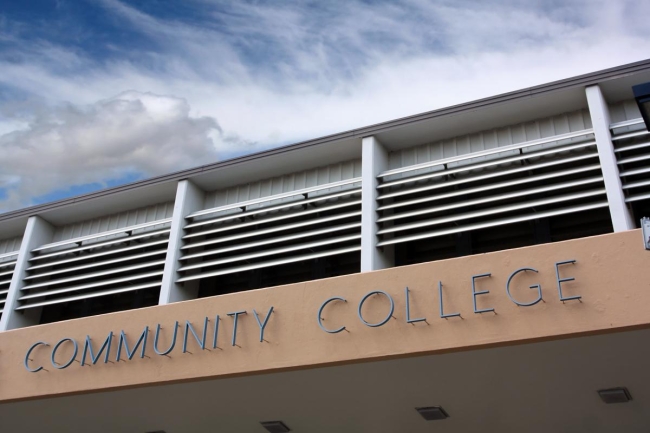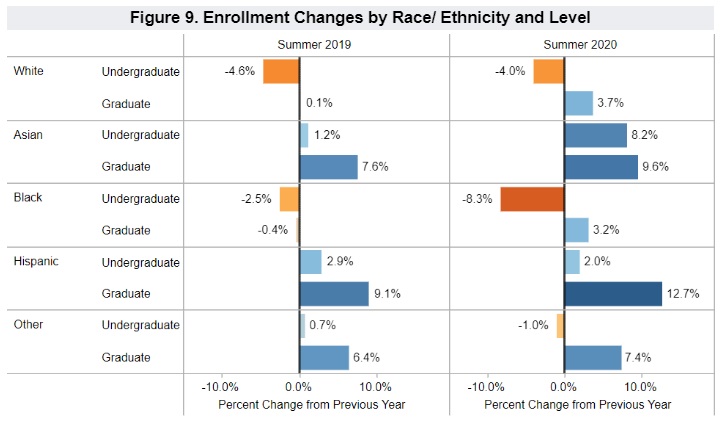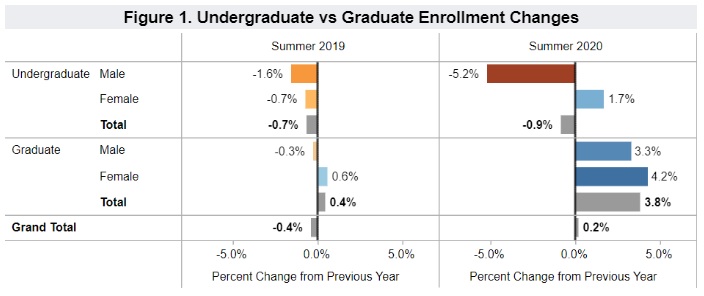You have /5 articles left.
Sign up for a free account or log in.

crisserbug/Getty Images
As some experts feared, the biggest college enrollment declines this summer were among vulnerable student populations, potentially widening equity gaps in college access for Black students, students who attend community colleges and for-profits, and men.
The National Student Clearinghouse Research Center today released its latest report on U.S. college enrollments, finding steep declines this summer among those and other groups of students. The findings are a stark contrast to countercyclical enrollment gains of previous recessions, as the pandemic continues to defy precedent.
The overall enrollment picture was more mixed, as largely flat undergraduate enrollment (down 0.9 percent compared to last summer) was offset by a spike in graduate enrollments (up 3.8 percent). The result was a 0.2 percent increase in total enrollment, up from a 0.4 percent decrease last summer.
Yet big decreases in associate degree program enrollments (5 percent) raise the stakes for the community college sector, which appears to be struggling with further drops for the fall term, while awaiting potentially severe cuts to state and local government funding. Rural four-year institutions also saw big enrollment declines.
Undergraduate certificate programs took an even larger enrollment hit this summer (11.7 percent) despite growing interest in short-term and online alternative credential pathways, which have been projected to expand.
U.S. college enrollments have been declining for nine years, due in part to the now-halted economic recovery in the last recession’s wake and to demographic shifts away from traditional college-age students. Higher education generally has struggled to enroll enough adult students to counteract that shift.
Meanwhile, the industry largely has failed to close equity gaps in college access and completion for Black, Latino and lower-income students.
That challenge worsened this summer (except for Latino student access, with Latino enrollment up 2 percent for undergraduates and a whopping 12.7 percent in graduate programs).
“Here are the numbers to confirm our fears,” said Kim Cook, executive director of the National College Attainment Network, which has been tracking declines in the renewals and filing of the Free Application for Federal Student Aid so far this year.
Cook pointed to summer drops in enrollment among Black students and at community colleges as particularly alarming. “If they are the proverbial canary in the coal mine for the fall, that’s very concerning.”
One reason, she said, is the importance of continuous enrollment for students to increase the odds they eventually earn a college credential, particularly for students from underserved backgrounds.
“Our students don’t take gap years,” said Cook, referring to the lower-income college students the network advises. “I can only hope those community college enrollments will come back, because that means students are staying on track.”
Big Decline in Black Student Enrollments
Some of the largest enrollment declines this summer were among Black undergraduates (8.3 percent), the Clearinghouse Research Center found. (Black graduate student enrollments were up 3.2 percent.)
The drops for Black students were steepest in the community college sector (10.5 percent), followed by for-profits (6.8 percent), private nonprofit colleges (5.2 percent) and public four-year universities (2.7 percent).
And while Latino student enrollments were up this summer in all other sectors, they were down 2.6 percent at community colleges.
The overall enrollment gains for Latino students are promising, said Wil Del Pilar, vice president of higher education policy and practice at the Education Trust. “But it’s not a guarantee for the fall,” he cautioned, pointing to other reports that raised concerns about declines in enrollment being most likely among students of color.
Even so, Del Pilar said the new summer enrollment figures are a serious concern.
“We should be paying significant attention to this,” he said. “It’s a precursor for the fall.”
Black and Latino Americans have been disproportionately impacted by the pandemic and recession, he noted, with unemployment rates that are substantially higher than those of white Americans. The health and economic impacts suffered by people of color, coupled with existing wealth gaps and concerns about the racial climate in higher education, all could be contributing to the steep decline in enrollment among Black students, said Del Pilar.
“Institutions need to pay special attention to their data and their policies and target their resources” to students who need the most help, he said, including financial aid, advising and counseling, and debt relief.
The Clearinghouse Research Center also found that white undergraduate enrollments were down -- 4 percent over all and 8 percent at community colleges -- while white graduate student enrollments were up 3.7 percent. Enrollments among Asian American students were up across the board, topped by those who attended four-year publics (11.9 percent).
College access among men also took a hit this summer. Enrollments were down 5.2 percent among male undergraduates over all, and 13.6 percent at public two-year institutions, compared to a decline of less than 1 percent in enrollments of women undergraduates compared to last summer.
The divergence in enrollments between men and women were among the findings that most surprised Doug Shapiro, executive director of the National Student Clearinghouse Research Center. While enrollments of men had lagged that of women for some time, this spread is wider, he said.
Likewise, Shapiro said enrollments at community colleges and for-profits this summer did not fit the historic profile of recessions, where people who lose jobs or pay are more likely to go to college to gain skills while riding out a downturn.
“A lot of the findings were unexpected,” he said, adding that the numbers raise more questions than they can answer. “This really is nothing like what we’ve seen in the past.”
Big Hits to Community Colleges, Rural Institutions
The four-year, nonprofit college sectors saw modest enrollment growth this summer -- at four-year public colleges and universities (2.8 percent) and four-year private institutions (4 percent).
Those increases contrasted sharply with the declines at community colleges (5.6 percent) and four-year for-profits (7 percent).
Community colleges also tend to be funded by state governments at lower levels per student than are four-year institutions. And they were dinged by the federal stimulus, the CARES Act, because community colleges generally enroll larger percentages of part-time students, who were de-emphasized in the head-count formula used for the stimulus funds.
“We continue to underresource the institutions that serve the most students who are the most vulnerable,” said Del Pilar.
Likewise, he said community college students are more likely to struggle with internet access for programs that are now offered online.
In addition to community colleges, rural four-year institutions also saw large enrollment declines this summer, the research center said, including public four-years located in rural areas (8.1 percent) and rural private four-year institutions (4.9 percent).
Both the public and private four-year sectors, however, saw enrollment increases at institutions in urban and suburban locations.
The report is the first of a new research series, the research center said, which will use the latest data available. It will be updated each month, highlighting year-over-year changes with pre-pandemic baselines and enrollment data for various subgroups of students, programs, institutions, states or regions.
The research center has student-level data that are virtually comprehensive and can track students as they move across institutions, unlike the federal government. Shapiro said these reports will be nationally representative with various demographic and other breakouts, but released quickly and before all data are reported. The reports will be revised and updated as warranted.
“We’re trying to push back on the vacuum and the level of speculation and anecdote that tends to fill the vacuum about what’s happening,” said Shapiro. “We want the education community to be able to act on the best information that’s available.”








